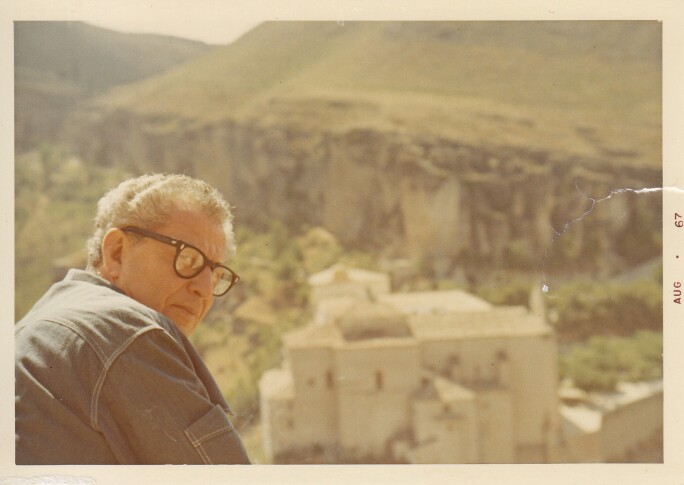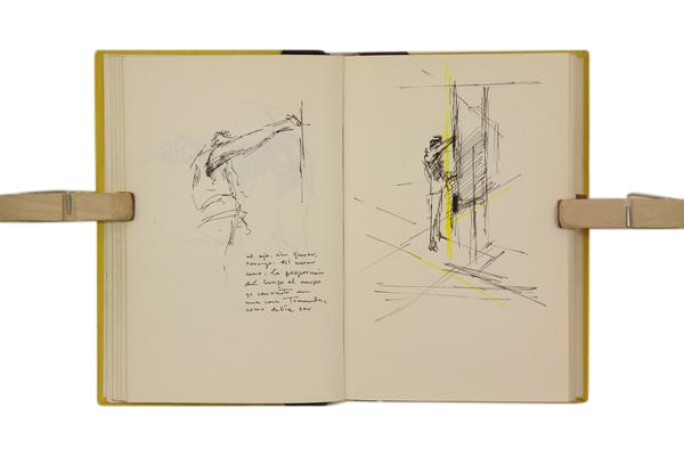F
ernando Zóbel de Ayala y Montojo was born in Manila of Spanish parents, studied at in the United States, Harvard, eventually settled in Spain and died in Rome; his life and work spanned three continents, thus anticipating the best of today’s global world. His oeuvre is a constant mediation between light, color and essence: an attempt at revealing truth through reduction to an essence in lyrical abstraction.
Zóbel dedicated the present work to a friend and mentor, Bernard Childs (1910–1985), an American artist who worked in Paris and New York. He was primarily a painter and printmaker who pioneered the direct engraving of metal plates with power tools, a technique that Zóbel learned from Childs and adopted in his own practice. As a kind of counterpoint to his often-abstracted figurative work, Childs also started painting portraits. The present lot, titled Bernard Childs pintando mi retrato en su estudio de Paris (Lot 1019) was inspired by the later.

1967 年 8 月,伯納德·柴爾斯位於昆卡的場景。 照片由費南度・索培爾拍攝
Zóbel painted the present work during his 1967 visit to Bernard Childs and his family in Paris while Childs was at the same time painting Zobel’s portrait. Bernard Child's wife Judith Childs, recalls Childs asked Zóbel to go buy himself a yellow shirt for the sitting. The Childs delivered Zóbel's portrait to him in Cuenca in August 1967, and Zóbel took their photos during their visit. In Paris, Zóbel would visit the Louvre, some galleries and his friend Bernard Childs, who gave him engraving sessions. Zóbel would explore different etching and printmaking techniques in his work and over many years maintain correspondence and exchanges with Childs.
“There is nothing more pleasurable than watching somebody do something he knows how to do really well. When inking a plate, Bernard uses his head more than most of the painters that I know use theirs when they’re painting a picture. (He doesn’t like etching, he finds it indirect). When we leave the studio, we’re in a daze, our heads bursting, and we go to Charbonnel to buy materials.”

費南度·索培爾, 速寫本, no. 62, 1967年, 費南度·索培爾檔案館, 圖書館和研究中心,胡安馬奇基金會,馬德里。
Zóbel captures in his distilled abstract language Childs’ painting process: we see simplified squares, sharp lines and shades of ochre and greys, hinting at what could be a canvas, an easel and a blurred figure’s profile. The stylistic elements seen in the present lot, further echo Childs’ and Zóbel’s aligned interests in the formal qualities of line, space, light and color.
Demonstrating Zóbel’s immense curiosity and intellectual rigor, the present lot plays on multiple levels on the notion of subject and creation: an artist painting another artist painting himself. It not only signifies the close relationship and the great influence of Bernard Childs on Zóbel’s works, but also exemplifies Zóbel’s heightened sense of observation and analytics of art creation. Some of Zóbel’s strongest works derive from a deep admiration, breakdown, and reinvention of an existing work of art, refreshing a known masterpiece through a new abstracted lens.
The present work is emblematic of Zóbel’s works shown currently at a special exhibition at Museo Nacional del Prado, Madrid titled The Future of the Past. The exhibition showcases how Zóbel focused intensively on the paintings in the Prado collection, studying and thereafter reinventing masterpieces through his own creative process. Zóbel accesses modernity in his encounters in Europe and Asia, as well as the vernacular tradition of the Philippines and in Japanese and Chinese painting.
Likewise, in this work we see the product of studious drawings and acute observations, that encompass within them his effort to understand the artistic intention that motivated the painters. The essence of a scene is reduced to simple geometric shapes, a play with line, shadow, and light.
Bernard Childs pintando mi retrato en su estudio de Paris is a direct comparable with Zóbel's The Dream of the Damsel currently in the permanent collection of the Harvard Art Museums/Fogg Museum. Both works were executed in the same year in 1967 and their sublime compositions were inspired by existing paintings, and demonstrate Zóbel's acutely analytical yet expressive vernacular.
費南度・索培爾出生於馬尼拉,父母是西班牙人,他曾留學美國哈佛大學,後來定居西班牙,最終在羅馬去世。索培爾的生活和創作橫跨三大洲,他的作品因而融和了現今多個地區的藝術精華。他以不斷平衡光、色彩和發掘本質為創作重心,嘗試用抒情的抽象表現簡化畫面,揭示藝術的真正本質。索培爾將本作獻給良師益友、美國藝術家貝爾納・柴爾斯(1910–1985),他生前活躍於巴黎和紐約。柴爾斯主要創作繪畫和版畫,是最早以電動工具直接在金屬板鐫刻的版畫藝術家,索培爾向柴爾斯學習這種技術,並融入自己的創作中。柴爾斯也受索培爾的抽象化具象作品潛移默化,開始創作肖像畫。本作《伯納德·柴爾斯為我畫的肖像畫》(拍品編號1019)正是索培爾受柴爾斯啟發而創作。
《伯納德·柴爾斯為我畫的肖像畫》繪於1967年索培爾到巴黎拜訪貝爾納・柴爾斯一家之時,同一時間,柴爾斯也正在繪畫索培爾的肖像畫。索培爾逗留巴黎期間,參觀了羅浮宮和不少畫廊,柴爾斯也教授他製作銅刻版畫。此後,索培爾在創作中也試圖探索各種金屬版畫技巧,多年來一直與柴爾斯保持交流。
貝爾納・柴爾斯的遺孀茱蒂絲・柴爾斯憶起,她丈夫曾經要求索培爾先買黃色恤衫才給他當模特兒,她說︰「貝爾納將完成的畫作轉向費南度,費南度問︰『但黃色恤衫在哪裡?』貝爾納回答︰『在那裡。』」 1967年8月,茱蒂絲和貝爾納・柴爾斯將索培爾的肖像送抵昆卡,索培爾也趁柴爾斯夫婦到訪時為他們拍照留念。柴爾斯為索培爾繪畫的肖像現由私人收藏,而與這幅肖像相關的素描,現由昆卡的抽象藝術博物館收藏。
「再沒有事情比看著人做擅長的事更令人高興了。貝爾納替金屬版上墨時,比我認識的大多數畫家畫畫時更花心思(他不喜歡蝕刻版畫,認為不夠直接)。我們離開工作室時大家都懵了,頭像是快要爆開,就去夏勃納那店買版畫材料了。」
索培爾從柴爾斯的作畫過程中提煉出抽象的藝術語彙︰畫中精簡的正方形、利落的線條、各種赭色與灰調,都似是指向畫布、畫架和人物的模糊輪廓。本作的簡化元素進一步呼應柴爾斯和索培爾的共同特質,就是二人都對線條、空間、光、色彩等造型能力深感興趣。 本作展現了索培爾無比的好奇心和精密的心思,他以一個藝術家描繪在為自己畫像的藝術家為主題,從多個層次思考主體和創作的概念。本作反映了柴爾斯與索培爾的作品關係緊密,影響甚深,更展示了索培爾對創作擁有敏銳的觀察力和分析力。索培爾不少精彩之作,創作靈感正是源於他對其他藝術作品的欣賞之情,再加以拆解再造,以全新的抽象視角展現大師傑構。
普拉多美術館剛舉行索培爾的特展「索培爾︰過去的未來」(Zobel. The Future of the Past),本作正是體現索培爾成就的代表作。特展展示了索培爾集中研究過普拉多美術館收藏的畫作,再透過自己的理解來創作,以抽象表現重現以往大師的作品。索培爾在歐洲和亞洲經歷的一切、菲律賓的文化傳統,以及日本畫與中國畫,都啟發了他對現代性的思考。 同樣地,本作是索培爾用心習畫和敏銳觀察的成果,他嘗試理解推動畫家創作的動機,所付出的時間和精神都體現在本作中。他將整個場景簡化成幾何圖案,以線條與光影營造畫面的空間感。
《伯納德·柴爾斯為我畫的肖像畫》可直接與獲哈佛藝術博物館/福格藝術博物館永久收藏的《少女之夢》互相比較。兩幅畫作都繪於1967年,同樣都是索培爾從大師傑作獲取靈感而創作,也可見索培爾用抒情的藝術語彙展示精準的分析力。